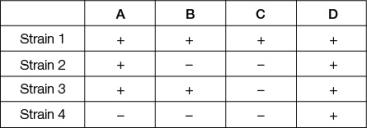Multiple Choice
Suppose that a certain wild-type bacteria can synthesize substance D, but various mutant strains cannot.We know that substance D is synthesized from substance X in a pathway that involves three intermediate substances (A, B, and C) , but we do not know the order of the steps in the pathway.The table shows four different mutant strains that have been tested for their ability to grow on the various substances.The "+" means that the strain can grow on that substance.The "‒" means that the strain cannot grow on that substance.  If another strain (say, strain 5) grows on substance B but does not grow on substance C, we can infer that it
If another strain (say, strain 5) grows on substance B but does not grow on substance C, we can infer that it
A) can grow on substance A.
B) cannot grow on substance A.
C) has a defect in the enzyme that converts substance B into substance C.
D) cannot grow on substance D.
E) has a defect in the enzyme that converts substance D into substance B.
Correct Answer:

Verified
Correct Answer:
Verified
Q76: Refer to the figure. <img src="https://d2lvgg3v3hfg70.cloudfront.net/TB5650/.jpg" alt="Refer
Q77: RNA differs from DNA in its base
Q78: A posttranslational modification commonly used by signal
Q79: Wild-type bacteria can synthesize substance D, but
Q80: In RNA viruses, single-stranded RNA replicates by<br>A)
Q82: Which statement about translation is false?<br>A) Translation
Q83: The anticodon 3ʹ-UAC-5ʹ will bind to which
Q84: Consensus sequences (short segments of DNA) appear
Q85: Initiation of translation of an mRNA has
Q86: The gene product _ translates mRNA into